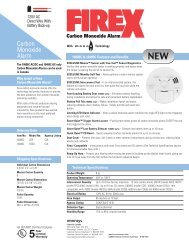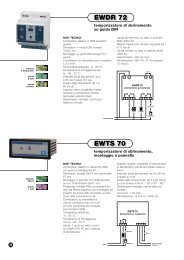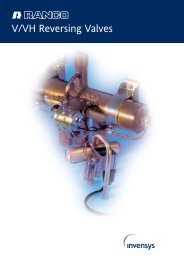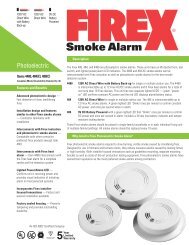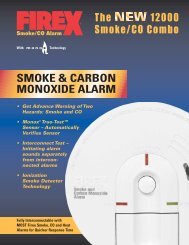SMOKE/CARBON MONOXIDE ALARM MODEL FADCQ - FireX
SMOKE/CARBON MONOXIDE ALARM MODEL FADCQ - FireX
SMOKE/CARBON MONOXIDE ALARM MODEL FADCQ - FireX
You also want an ePaper? Increase the reach of your titles
YUMPU automatically turns print PDFs into web optimized ePapers that Google loves.
VII: IMPORTANT SAFETY INFORMATION<br />
Fire Safety Tips<br />
These guidelines will assist you in the event of a<br />
fire. However, to reduce the chance that fires will<br />
start, practice fire safety rules and prevent hazardous<br />
situations.<br />
• Familiarize everyone with the sound of a<br />
smoke alarm and explain what it means.<br />
• Determine TWO exits from each room and an<br />
escape route to the outside from each exit.<br />
• Teach all household members to touch the<br />
door. INSTRUCT THEM NOT TO OPEN THE<br />
DOOR IF THE DOOR IS HOT.<br />
• Teach household members to crawl along the<br />
floor to stay below dangerous smoke, fumes,<br />
and gases.<br />
• Determine a safe meeting place for all<br />
members outside the building.<br />
CO Home Safety Tips<br />
CO poisoning is often caused by equipment failures<br />
due to poor maintenance, product defects,<br />
and damaged parts. The following is a list of<br />
safety tips to help prevent CO within your home:<br />
1. Have all fuel-burning appliances inspected<br />
and cleaned yearly by a qualified service<br />
technician. The furnace, water heater, and<br />
stove are some of the leading sources of CO.<br />
2. Clean fireplace vents and chimney regularly. A<br />
blocked chimney could cause a backdraft of<br />
CO into the home. Do not cap chimney. This<br />
will cause a backdraft of CO into the home.<br />
3. Do not cap or cover a draft hood or exhaust<br />
vent to any appliance. This will trap dangerous<br />
CO inside the house.<br />
23<br />
What to Do in Case of a Fire<br />
1. Don’t panic; stay calm.<br />
2. Leave the building as quickly as possible.<br />
Touch doors with the back of your hand to<br />
feel if they are hot before opening them. IF<br />
DOOR IS HOT USE AN ALTERNATE EXIT.<br />
Crawl along the floor, and DO NOT stop to<br />
collect anything.<br />
3. Meet at a pre-arranged meeting place outside<br />
the building.<br />
4. Call the fire department from OUTSIDE the<br />
building.<br />
5. DO NOT GO BACK INSIDE A BURNING<br />
BUILDING. Wait for the fire department to<br />
arrive.<br />
4. Do not close off or confine your fuel-burning<br />
appliances in a closed area. They need<br />
plenty of ventilation to operate properly.<br />
5. Do not use liquid propane (LP) or charcoal<br />
grills indoors.<br />
6. Do not operate any gasoline-powered equipment<br />
indoors.<br />
7. Allow for plenty of ventilation when using a<br />
kerosene heater. Do not use in small areas.<br />
Preventive maintenance, common sense, and a<br />
CO detection device are some of the best methods<br />
of preventing CO poisoning. However, a<br />
dangerous situation can happen to anyone at<br />
any time.<br />
Continued...



